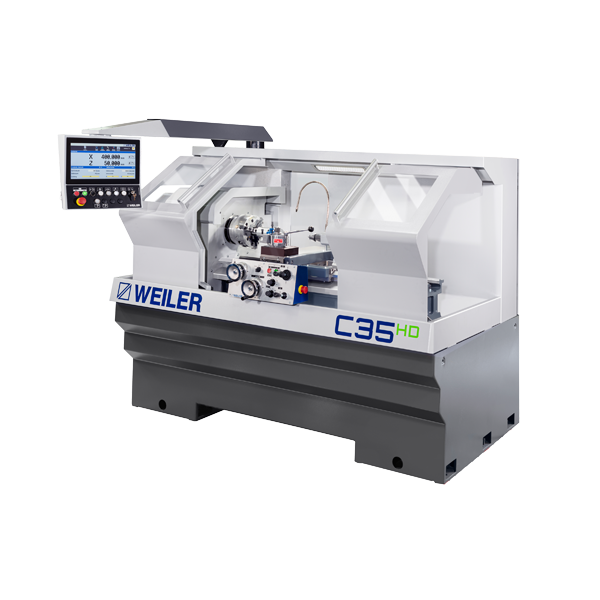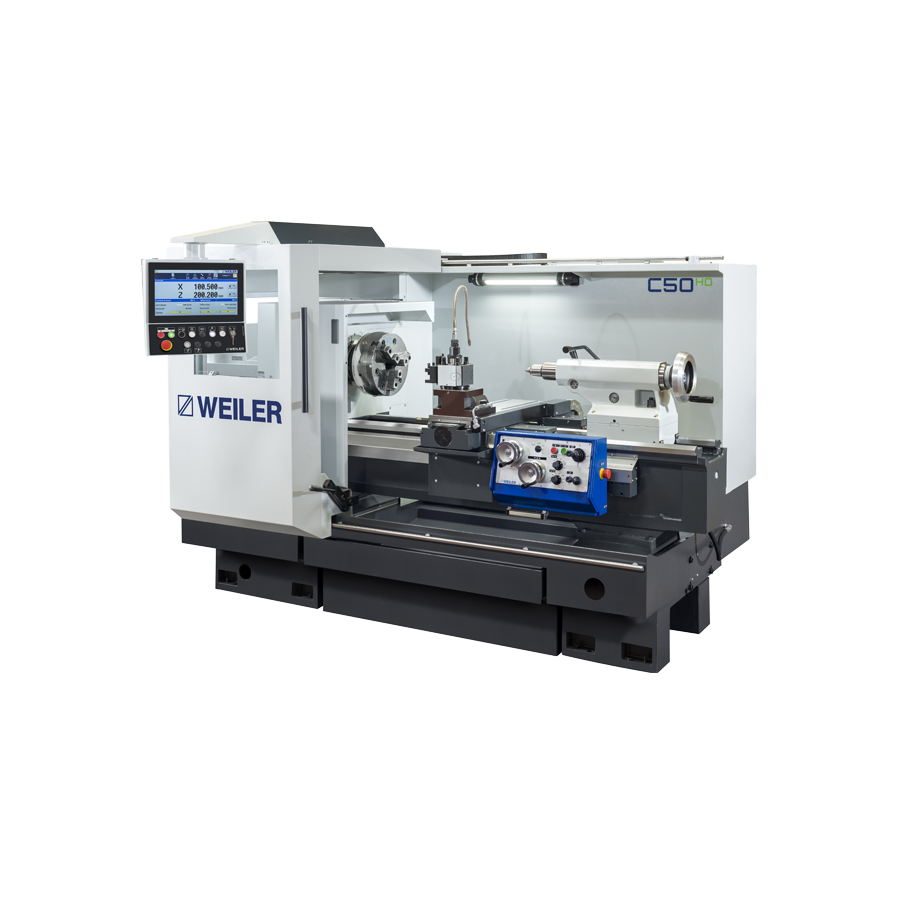Servo-conventional lathes – your entry into digital turning
Made in Germany: Servo-conventional lathes from WEILER
The C series of servo-conventional lathes from WEILER forms the bridge between conventional lathes and cycle lathes. With them, the user can concentrate on the essentials. There is no need to set a speed on the gearbox or swap change gears to cut threads on servo-conventional lathes. This reduces sources of error and increases productivity.
The two models C35HD and C50HD combine state-of-the-art drive technology with a unique operating concept developed by WEILER. Operators used to conventional lathes can easily and quickly produce complex workpieces with a servo-conventional machine. Only simpler, faster, more precise and more economical than manual turning.
WEILER quality made in Germany
Like all precision lathes, the servo-conventional models are also manufactured at our Emskirchen site in northern Bavaria.
The most important advantages servo-conventional lathes:
- Precise work: Toolmaking accuracy according to DIN 8605
Servo-conventional lathes are highly precise. The constant cutting speed with a selectable speed limiter and an override switch for the feed and work spindle speed contribute to this, for example.
They can also be operated down to the µ via handwheels that are connected to the bed slide. This enables precise and sensitive working, high accuracy, fine surface qualities and high productivity. - Easy to operate
As the handling is similar to that of conventional lathes, it can be learnt without extensive training. The intuitive control panel enables the machine to be set up and customised quickly. The operator can work with the machine after just a short time. CNC knowledge is not required. - Quickly master a wide range of tasks with simple cycles
In addition to conventional machining, it is also possible to use pre-programmed single cycles, as known from cycle lathes.
There are ready-made input masks for various machining tasks. These make it easier to turn tapers, radii, threads and recesses so that parts can be produced more quickly and economically. - Shortest set-up times for individual parts, small series and in training
Servo-conventional machines are ideal for turning individual parts and small batch sizes in mechanical engineering, maintenance and training. They are ideal for single part and small batch production in many areas. These range from production in trade, commerce and industry to toolmaking and scientific research. The machines are robust, precise and quickly ready for universal use. - Favourable purchase and maintenance costs
Compared to fully automated CNC machines, servo-conventional lathes are less expensive to purchase and maintain. As a result, they offer an excellent cost-benefit ratio and are therefore just as interesting for smaller workshops and companies as they are for large companies. - Economical in consumption
The machines already consume little power by default. The optional “e-Tim” energy-saving system, which minimises energy consumption, offers an additional way to conserve resources.
“e-TIM” regulates the energy consumption of machines in three ways:
– the braking energy is consistently fed back into the power grid,
– It automatically switches off the auxiliary units that are not required during processing
– and when the machine is at a standstill, “e-TIM” switches to standby mode. - Modern controls with touchscreen
The servo-conventional machines are equipped with the modern Weiler C4 control software based on the SINUMERIK ONE CNC system from Siemens. They are operated via a 15-inch touchscreen on a rotating control panel, with operation modelled on that of smartphones and tablets. A context-sensitive help menu assists with familiarisation. In addition to a data memory for 99 tools, there is also a network connection and a USB interface for importing files.
The two servo-conventional lathes C35HD and C50HD
The C35HD is suitable for diameter ranges of 360 mm and centre distances of 800 mm, while the C50HD has a diameter range of 570 mm and centre distances of 1000/2000 mm. Both have a powerful 9 kW main spindle housed in a thermo-symmetrically designed headstock, which ensures smooth running over the entire speed range. The precision-ground ball screw spindles and stable guides also ensure high contour accuracy and long-term precision.



